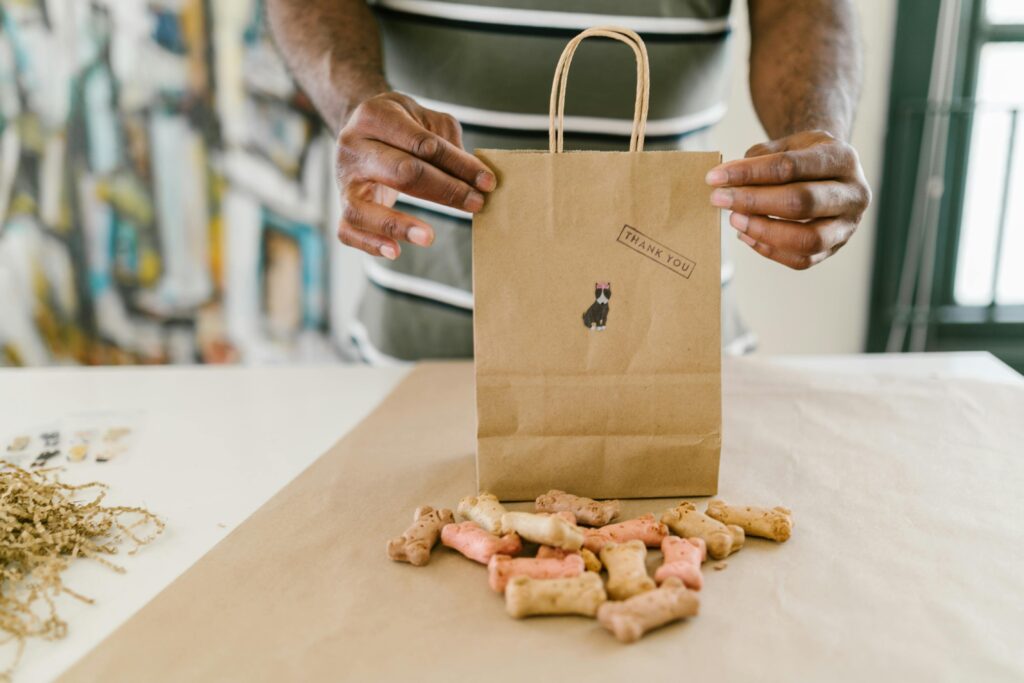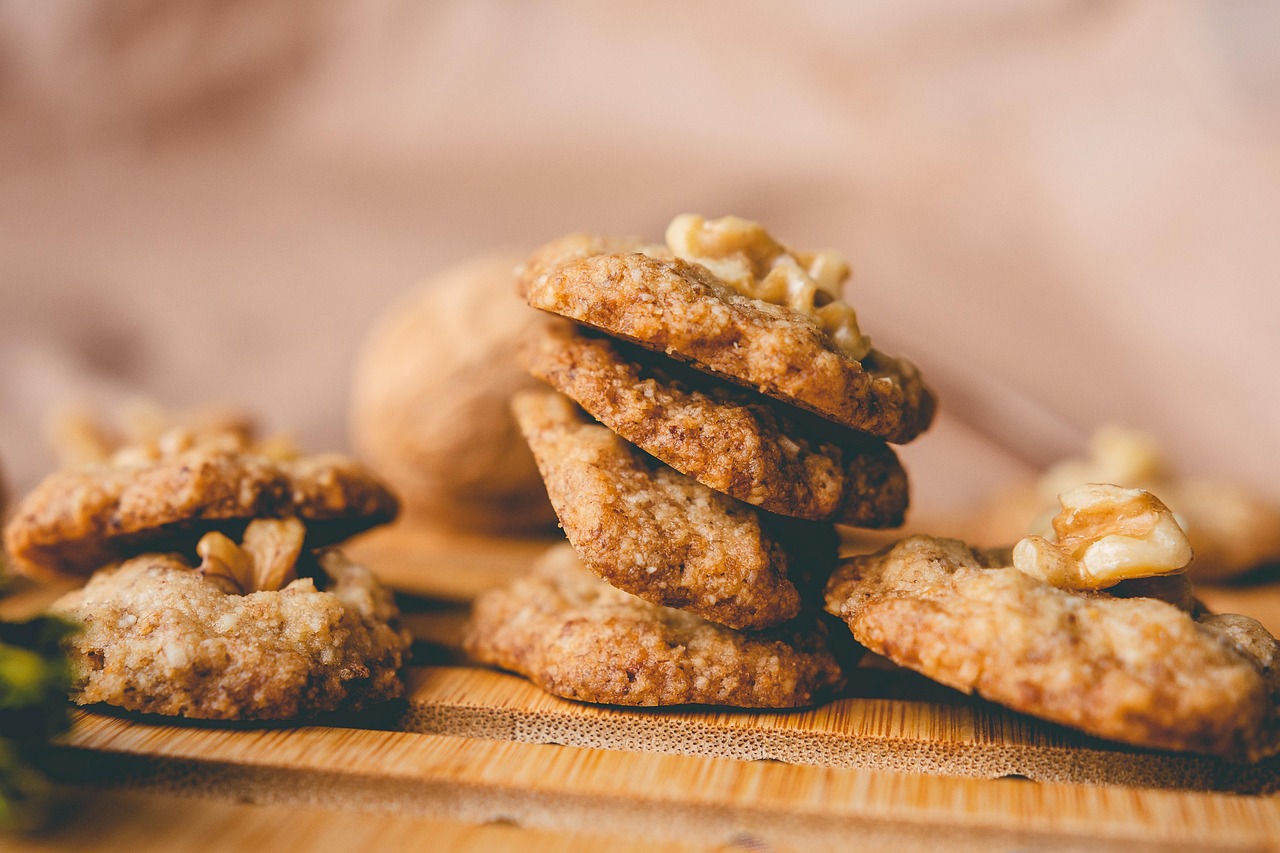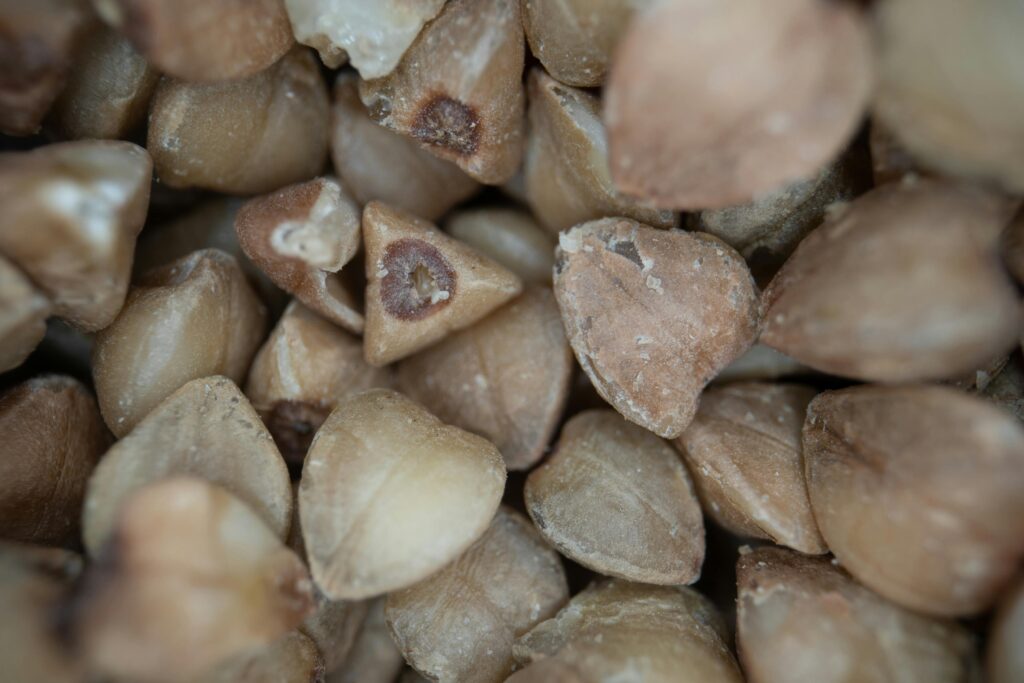Ingredients to Avoid in Homemade Dog Snacks
Just as there are safe and healthy ingredients, there are also dangerous ones that should never find their way into your dog’s bowl. Some foods that are harmless to humans can be toxic—even deadly—for dogs.
1. Toxic Foods for Dogs:
- Chocolate (contains theobromine, harmful to the nervous system)
- Grapes and raisins (can cause kidney failure)
- Onions and garlic (damage red blood cells)
- Avocado (contains persin, toxic to dogs in large amounts)
- Macadamia nuts (cause weakness and tremors)
2. Unsafe Household Ingredients:
- Salt and salty snacks (can lead to sodium ion poisoning)
- Artificial sweeteners like xylitol (cause a dangerous drop in blood sugar.
- Caffeine (toxic stimulant)
- Alcohol (even in small amounts) can be fatal.
- Raw yeast dough (expands in the stomach and causes bloating)
3. How to Ensure Safety:
Always double-check ingredients before preparing snacks. Even if a recipe looks safe online, some ingredients might be overlooked. Reading labels carefully is crucial—especially when using peanut butter, as some brands sneak in xylitol.
Avoiding harmful ingredients is the first step to ensuring your homemade snacks truly benefit your dog’s health.
Easy Homemade Dog Snack Recipes
Now that you know what’s safe and what’s not, let’s explore some simple yet nutritious recipes. Each recipe uses dog-safe ingredients and can be prepared with minimal effort.
1. Peanut Butter and Banana Biscuits:
- Ingredients: whole wheat flour, ripe banana, natural peanut butter (xylitol-free), egg
- Instructions: Mash banana, mix with peanut butter and egg, slowly add flour, shape into biscuits, bake at 350°F (175°C) for 20–25 minutes.
- Benefits: Packed with protein and energy, great for active dogs.
2. Sweet Potato Chews:
- Ingredients: sweet potatoes
- Instructions: Slice into thin strips, bake at a low temperature (250°F/120°C) for 2–3 hours until chewy.
- Benefits: A fiber-rich, low-fat treat that aids digestion.
3. Chicken and Rice Bites:
- Ingredients: shredded cooked chicken, brown rice, egg
- Instructions: Mix all ingredients, form small balls, bake at 350°F (175°C) for 15–20 minutes.
- Benefits: Easy-to-digest protein snack, ideal for dogs with sensitive stomachs.
4. Oatmeal and Pumpkin Cookies:
- Ingredients: oats, canned pumpkin (unsweetened), egg, cinnamon (optional, small amount)
- Instructions: Combine oats and pumpkin, add egg, form into small cookies, bake at 350°F (175°C) for 20–25 minutes.
- Benefits: Supports digestive health and provides a chewy texture dogs love.
Each of these recipes is not only simple to prepare but also nutritious and dog-approved. With a little creativity, you can mix and match ingredients to suit your pet’s taste and health requirements.
How to Store Homemade Dog Snacks
Once you’ve baked a batch of delicious homemade snacks, the next important step is proper storage. Unlike store-bought treats, which contain preservatives to extend shelf life, homemade dog snacks are free of additives. While this makes them healthier, it also means they can spoil more quickly if not stored correctly.
1. Refrigeration:
For snacks made with perishable ingredients like meat, eggs, or dairy, refrigeration is essential. Store them in airtight containers and place them in the fridge. On average, these snacks last 5–7 days. To make things easier, label containers with preparation dates, so you know when it’s time to toss them out.
2. Freezing:
If you want to make larger batches, freezing is your best option. Most homemade dog treats freeze well, especially baked biscuits and meat-based snacks. Freeze them in small portions so you can thaw only what you need. Frozen snacks typically last for up to 3 months without losing their flavor or texture.
3. Room Temperature Storage:
Dry and crunchy snacks, like baked biscuits, can usually be stored in airtight jars at room temperature for up to 10–14 days. However, humidity can shorten their shelf life, so if you live in a humid area, consider refrigerating instead.
4. Packaging for Convenience:
Another tip is to store snacks in portion-sized bags or containers. This makes it easier to grab and go, especially when you’re taking your dog for walks or road trips.
Proper storage ensures that your homemade snacks remain safe, fresh, and tasty for your dog. Remember: if a snack smells strange, changes color, or grows mold, discard it immediately. Safety always comes first.
How Often Should You Give Snacks to Your Dog?
Snacks are great for training, bonding, and rewarding good behavior, but giving too many can lead to weight gain and other health issues. So how often should you really give your pup these tasty treats?
1. The 10% Rule:
Veterinarians recommend that snacks make up no more than 10% of your dog’s daily calorie intake. The rest should come from their balanced dog food. For example, if your dog needs 800 calories per day, snacks should be limited to around 80 calories.
2. Training Purposes:
During training sessions, treats are essential for reinforcing positive behavior. In this case, choose small, low-calorie snacks and break them into tiny pieces to avoid overfeeding.
3. Rewarding Good Behavior vs. Random Snacking:
It’s better to give snacks with purpose—whether it’s training, rewarding, or bonding—rather than handing them out randomly. This helps your dog associate treats with good behavior, making them more valuable.
4. Age and Health Considerations:
- Puppies may need more frequent snacks for training, but in smaller portions.
- Senior dogs may require softer, low-fat treats that are easier to chew and digest.
- Overweight dogs should get very limited snacks, ideally using veggies like carrots or green beans.
By being mindful of how often you give snacks, you’ll ensure your dog enjoys treats without compromising their health.
Homemade Snacks for Dogs with Special Diet Needs
Not all dogs can enjoy the same snacks. Just like humans, some dogs have allergies, sensitivities, or specific dietary requirements. Making snacks at home allows you to customize recipes to suit your dog’s needs.
1. Grain-Free Treats:
Some dogs are sensitive to grains like wheat or corn. For them, use alternatives like oat flour, coconut flour, or chickpea flour. For example, you can make grain-free peanut butter cookies with coconut flour and eggs.
2. Low-Fat Treats for Overweight Dogs:
If your pup is on a weight management plan, consider snacks like dehydrated vegetables, rice cakes, or low-fat yogurt drops. Avoid high-fat ingredients like cheese and fatty meats.
3. Hypoallergenic Snacks:
Dogs with food allergies need carefully selected ingredients. Common allergens include chicken, beef, wheat, and soy. If your dog is allergic to chicken, try turkey or fish-based recipes. Always introduce new snacks slowly and monitor for reactions.
4. Diabetic-Friendly Treats:
For dogs with diabetes, avoid high-sugar fruits like bananas and opt for low-glycemic options like green beans, cucumbers, or pumpkin-based treats. Consult your vet for safe recipes.
5. Senior Dog Snacks:
Older dogs may struggle with chewing, so opt for soft snacks like baked pumpkin bites or yogurt-based treats. Adding glucosamine powder to recipes can also support joint health.
Homemade snacks are especially beneficial for dogs with dietary restrictions because you can avoid harmful ingredients and cater to their health requirements.
Tips for Making Homemade Dog Snacks Fun and Engaging
Making snacks is not just about nutrition—it can also be a fun activity for both you and your dog. Here are some tips to take it up a notch.
1. Use Fun Shapes:
Invest in bone-shaped or paw-print cookie cutters to make biscuits more appealing. Dogs may not care about shapes, but humans do—and it makes snack time more enjoyable.
2. Involve Your Dog in the Process:
Let your dog watch you prepare the snacks. The smells and sounds of the kitchen will excite them, and when they finally get to taste the treat, it becomes even more rewarding.
3. Try Frozen Snacks for Hot Days:
Blend yogurt, peanut butter, and fruit, then freeze them in ice cube trays for refreshing summer treats. They’re like dog-friendly popsicles!
4. Experiment with Recipes:
Don’t be afraid to get creative. For example, mix pumpkin and applesauce into oat-based cookies, or try salmon and sweet potato bites for a protein-packed treat.
5. Make Snack Time Interactive:
Use toys like treat-dispensing balls or puzzle feeders. Hiding homemade snacks in these toys not only entertains your dog but also stimulates their brain.
When you make snacks engaging, it turns a simple treat into a bonding experience and an opportunity for mental stimulation.
Mistakes to Avoid When Making Homemade Dog Snacks
Even with the best intentions, pet owners can make mistakes when preparing dog treats. Avoiding these pitfalls will keep your dog healthy and happy.
1. Using Unsafe Ingredients:
As mentioned earlier, ingredients like chocolate, onions, and xylitol are toxic to dogs. Always double-check before adding something new to a recipe.
2. Overfeeding Snacks:
Even healthy treats can cause obesity if given in excess. Stick to the 10% calorie rule and balance snacks with exercise.
3. Skipping Storage Guidelines:
Homemade snacks don’t last as long as commercial ones. Storing them incorrectly can lead to spoilage and foodborne illnesses.
4. Not Considering Your Dog’s Needs:
Every dog is different. A recipe that works for one might not be suitable for another, especially if your dog has allergies, diabetes, or digestive issues.
5. Using Seasonings and Spices:
We may love adding salt, sugar, or spices to our food, but these can harm dogs. Always keep snacks plain and natural.
By avoiding these common mistakes, you’ll ensure that your homemade dog snacks are safe, nutritious, and enjoyable.

Homemade Snacks vs. Store-Bought Snacks: Which is Better?
When it comes to choosing between homemade and store-bought snacks, many dog owners find themselves torn. Both options have their pros and cons, but understanding the differences can help you make the right choice for your pup.
1. Ingredients:
- Homemade Snacks – You have complete control over what goes in. No preservatives, artificial colors, or harmful fillers. Everything is fresh and natural.
- Store-Bought Snacks – While some premium brands use natural ingredients, many still include artificial additives, excess salt, and unnecessary sugars.
2. Cost:
- Homemade Snacks – Generally more affordable, especially if you make large batches. Buying in bulk reduces the cost per treat significantly.
- Store-Bought Snacks – Convenient but often more expensive in the long run, especially if you go for organic or specialty treats.
3. Convenience:
- Homemade Snacks – Require time and effort to prepare, bake, and store. Not always ideal for busy pet owners.
- Store-Bought Snacks – Easy to grab, portable, and last longer on the shelf. Perfect for travel or quick rewards.
4. Customization:
- Homemade Snacks – Fully customizable for allergies, weight control, or special dietary needs.
- Store-Bought Snacks – Limited customization. You may need to shop around for grain-free, low-fat, or hypoallergenic options.
5. Shelf Life:
- Homemade Snacks – Shorter shelf life due to the absence of preservatives. Must be stored properly to avoid spoilage.
- Store-Bought Snacks – Longer shelf life, thanks to preservatives and packaging technology.
Verdict: Homemade snacks win when it comes to health, safety, and customization. Store-bought snacks win in terms of convenience and portability. Many owners find a balance—using homemade snacks for daily use and saving store-bought treats for travel or emergencies.
How to Introduce Homemade Snacks to Your Dog
Transitioning from store-bought snacks to homemade ones requires a little patience. Dogs, just like humans, can be picky eaters. Here’s how to do it smoothly.
1. Start Small:
Introduce homemade treats gradually. Start by offering one small piece alongside their usual store-bought snack. This prevents digestive upset and helps your dog get used to new flavors.
2. Watch for Reactions:
Monitor your dog closely for any signs of allergies or sensitivities. Symptoms may include itching, vomiting, diarrhea, or excessive licking. If you notice these, stop giving the new snack and consult your vet.
3. Mix and Match:
You don’t need to completely cut out store-bought snacks right away. Mix homemade and commercial treats for variety, slowly increasing the homemade portion.
4. Be Patient:
Some dogs take time to accept new flavors and textures. Keep experimenting with different recipes until you find one your pup loves.
5. Use During Training:
Dogs learn to associate snacks with positive experiences. Use homemade treats as training rewards so your dog builds a positive connection with them.
With time and consistency, your dog will start preferring homemade snacks because of their freshness and flavor.
Fun Homemade Snack Ideas for Different Occasions
Homemade snacks don’t have to be boring. You can create fun, themed treats for special occasions, making snack time even more exciting for your dog.
1. Birthday Treats:
Bake a dog-friendly cake made with oat flour, peanut butter, pumpkin, and yogurt frosting. Top it with a dog biscuit for decoration.
2. Holiday-Themed Snacks:
- For Halloween – Pumpkin cookies cut into bone or ghost shapes.
- For Christmas – Mint and parsley dog biscuits shaped like stars or trees.
- For Summer – Frozen watermelon cubes or yogurt popsicles.
3. Training Treats:
Make small, bite-sized chicken jerky or soft cheese balls. These are perfect for quick rewards without overfeeding.
4. Dental Chews:
Carrot sticks, apple slices, or homemade crunchy biscuits can double as dental chews to support oral hygiene.
5. Travel-Friendly Snacks:
Bake hard biscuits or dehydrate meat strips. These last longer and don’t require refrigeration, making them ideal for road trips.
Homemade snacks can be tailored to fit any celebration or activity, making your dog feel like part of the family’s special moments.
Signs Your Dog Loves Homemade Snacks
Dogs may not speak, but their body language says it all. Here are some signs that your homemade treats are a hit:
1. Tail Wagging and Excitement:
If your dog runs to the kitchen every time you start baking, that’s a clear sign they’re a fan.
2. Quick Consumption:
Dogs that love a treat will gobble it up quickly. If your dog lingers or leaves crumbs behind, the snack might not be their favorite.
3. Begging Behavior:
When your dog sits, stares, or paws at you for more, it’s a sure sign they enjoyed the taste.
4. Positive Reinforcement:
If your dog performs tricks or responds faster during training with homemade snacks, it shows they find them more rewarding.
5. Healthy Signs:
Beyond excitement, look for positive health indicators—shiny coat, healthy digestion, and consistent energy levels. These show that the snacks aren’t just tasty but nutritious too.
Dogs show love in many ways, and homemade snacks often become one of their favorite things.
Conclusion: Why Homemade Snacks Are the Best Choice for Your Dog
At the end of the day, homemade dog snacks are more than just food—they’re an expression of love and care. By preparing them yourself, you ensure that every bite is nutritious, safe, and tailored to your dog’s needs. Unlike store-bought treats that may contain preservatives, artificial ingredients, or hidden allergens, homemade snacks are pure, wholesome, and customizable.
They also help you save money, strengthen the bond with your pet, and give you peace of mind knowing exactly what goes into your dog’s body. Whether it’s a simple sweet potato chew, a peanut butter biscuit, or a frozen yogurt cube, these little snacks contribute to your dog’s health and happiness.
So next time you’re tempted to grab a packet of treats off the shelf, consider whipping up a batch of homemade goodies instead. Your dog will thank you with wagging tails, eager eyes, and unconditional love.
FAQs About Healthy Homemade Snacks for Dogs
1. Can I give my dog homemade snacks every day?
Yes, but keep them within 10% of your dog’s daily calorie intake. Snacks should never replace balanced meals.
2. How long do homemade dog treats last?
It depends on storage. Refrigerated treats last 5–7 days, frozen ones last up to 3 months, and dry biscuits last 1–2 weeks at room temperature.
3. Can I use regular flour in dog snacks?
Yes, but whole wheat, oat, or coconut flour is healthier. Avoid white flour if your dog has sensitivities.
4. Are raw snacks safe for dogs?
Some are, like carrots or apples, but avoid raw dough or meat unless recommended by your vet.
5. What’s the easiest homemade snack for beginners?
Sweet potato chews! Just slice, bake at a low temperature, and you’re done. They’re healthy, simple, and dogs love them.
Please don’t forget to leave a review.




